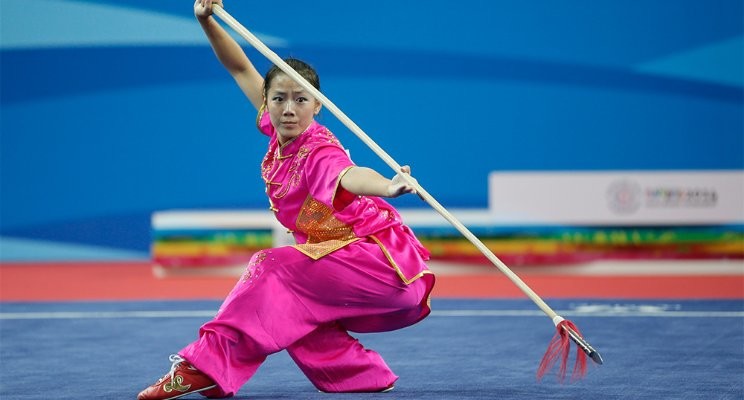
Taolu (Forms)
Exploring the Graceful Art of Taolu (Forms) in Wushu
Welcome to the enchanting world of Taolu, where movements become poetry, and discipline meets artistry. Taolu, also known as "forms" or "routines," is a quintessential aspect of traditional Wushu practice, captivating practitioners and audiences alike with its beauty, grace, and precision.
Origins and Significance
Taolu traces its origins back to ancient China, where it served not only as a means of self-defense but also as a form of artistic expression and cultural preservation. Over the centuries, Taolu evolved into a sophisticated discipline encompassing a vast array of movements, techniques, and styles, each reflecting the unique characteristics and philosophies of its respective lineage.
Elements of Taolu
At its essence, Taolu is a choreographed sequence of movements performed with fluidity, precision, and intent. These movements encompass a wide range of techniques, including kicks, punches, blocks, stances, and transitions, all seamlessly woven together to create a captivating narrative of motion and emotion.
1. Graceful Footwork and Stances
Central to Taolu are the intricate footwork patterns and stances that form the foundation of every routine. Practitioners move with elegance and poise, transitioning seamlessly between various stances such as horse stance, bow stance, and cat stance, each imbued with its own symbolic meaning and martial significance.
2. Dynamic Kicks and Strikes
Taolu showcases a dazzling array of kicks and strikes, ranging from the lightning-fast snap kick to the sweeping arc of the crescent kick. Each movement is executed with precision and control, combining speed, power, and finesse to create a mesmerizing display of athleticism and skill.
3. Fluid Transitions and Sequences
One of the hallmarks of Taolu is its emphasis on fluid transitions and seamless sequences of movements. Practitioners flow effortlessly from one technique to the next, maintaining a harmonious balance between speed and grace as they navigate through intricate patterns and combinations.
4. Expressive Forms and Interpretations
Beyond the technical proficiency, Taolu is also a form of artistic expression, allowing practitioners to convey their emotions, beliefs, and experiences through movement. Whether depicting the strength and resilience of a warrior or the serenity and balance of a sage, each Taolu routine tells a unique story, inviting audiences to embark on a journey of discovery and enlightenment.
Types of Taolu
Within the realm of Taolu, there are numerous styles and forms, each with its own distinct characteristics and attributes. Some of the most prominent styles include:
Changquan (Long Fist)
Changquan is renowned for its expansive movements, dynamic kicks, and fluid transitions. Practitioners of Changquan exhibit a wide range of techniques, including high jumps, spinning kicks, and intricate hand combinations, showcasing their agility, flexibility, and athleticism.
Nanquan (Southern Fist)
Nanquan emphasizes close-range combat, low stances, and explosive power. Unlike Changquan, which focuses on long-range techniques, Nanquan practitioners excel in delivering swift and powerful strikes at close quarters, utilizing rapid footwork and precise timing to overwhelm opponents.
Taijiquan (Tai Chi)
Taijiquan, often referred to as Tai Chi, is characterized by its slow, flowing movements and emphasis on internal energy cultivation. Practitioners of Tai Chi move with grace and fluidity, channeling their inner strength and mindfulness to achieve a state of harmony and balance.
Daoshu (Broadsword) and Jianshu (Straight Sword)
Daoshu and Jianshu showcase the techniques and forms associated with traditional Chinese weapons, including the broadsword (dao) and straight sword (jian). Practitioners demonstrate precision, speed, and control as they wield these weapons with finesse, executing a series of slashing, thrusting, and blocking techniques.
Training and Mastery
Becoming proficient in Taolu requires dedication, discipline, and unwavering commitment. Practitioners undergo rigorous training regimens, focusing on developing strength, flexibility, endurance, and mental focus. Through countless hours of practice and repetition, they refine their techniques, hone their skills, and strive for perfection in every movement.
Competition and Performance
Taolu competitions provide practitioners with a platform to showcase their talents and compete against fellow athletes on a regional, national, and international level. Judges evaluate performances based on criteria such as difficulty, execution, presentation, and overall artistic impression, rewarding those who demonstrate mastery, creativity, and originality in their routines.
Conclusion
In the world of Wushu, Taolu reigns supreme as a testament to the beauty, discipline, and artistry of martial arts. Through its graceful movements and expressive forms, Taolu transcends mere physicality, inspiring practitioners and audiences alike to embark on a journey of self-discovery, enlightenment, and personal growth. Join us at the Amature Association of Wushu Hisar as we celebrate the timeless tradition and enduring legacy of Taolu, where every step is a dance, and every movement is a masterpiece.